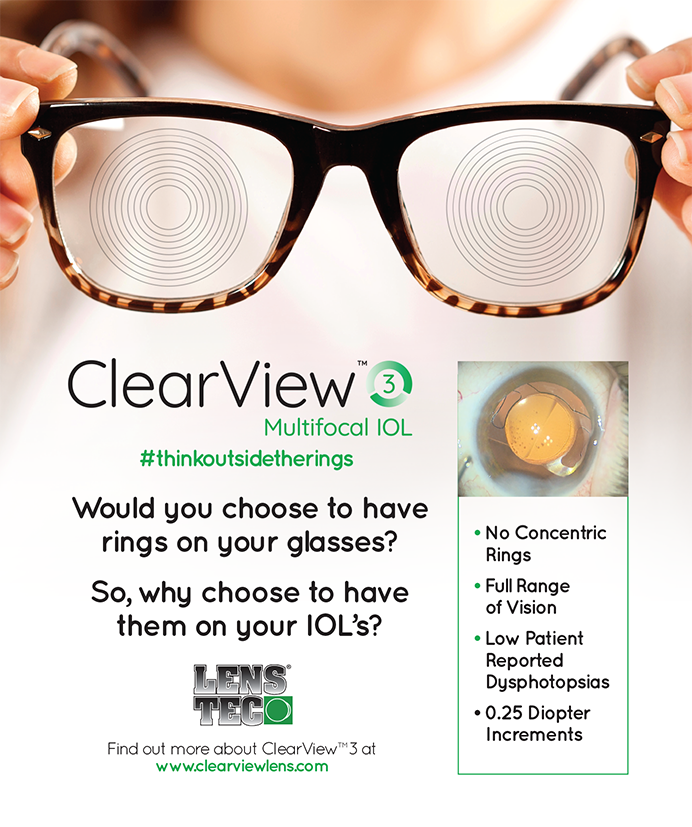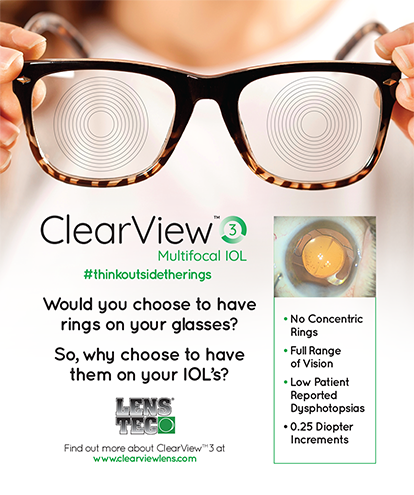I have seen the future of presbyopic surgery, and in my estimation, it is the Sapphire AutoFocal IOL (Elenza). Since the introduction of the first multifocal IOLs, we refractive cataract surgeons have used this excellent technology to treat presbyopia in patients undergoing lens-based surgery. We have felt that, in the very near future, however, true accommodating lenses will replace multifocal IOLs in the management of presbyopia during cataract surgery. Unfortunately, 20 years after the development of the first multifocal IOL, only one accommodating lens has been approved in the United States. Moreover, when these lenses correct a patient's vision for distance, they do not provide true near vision. The overwhelming problem with the current generation of accommodating lenses in the United States and abroad is that their functionality requires the movement of the capsular bag or of the lens within the capsular bag, both of which depend upon the eye's intraocular muscles. In many patients, the capsular bag contracts and hardens with age and thus becomes less pliable and less prone to movement. Elenza has sought to address these obstacles with the Sapphire AutoFocal IOL.
HOW DOES IT WORK?
For the first time, visual accommodation can occur without movement of the lens implant. Unlike a multifocal IOL, an accommodating IOL produces a single image. There are no problems with neuroadaptation, halos, or glare. The electroactive lens is programmable and patient specific, and it can be triggered manually by the patient. Sizing and centration are not critical with this IOL, as they are with mechanical accommodating lenses. The Sapphire does not have to capture energy from the patient's aging eye, and hardening of the capsular bag is not important.
The lens' ability to provide accommodation occurs via an electroactive liquid crystal optic encapsulated within an aspheric monofocal IOL. The lens contains a photovoltaic cell with photosensors that monitor the patient's pupillary dynamics associated with accommodation (Figures 1 and 2). The lens contains onboard processors that recognize the pupil's size in relation to illumination that will enable patient-specific programming so that the lens can provide accommodation based on the patient's individual and specific pupillary movements. The solid-state, rechargeable power cell activates a liquid crystal optic that changes between distance and near upon physiological triggers during near vision, and encapsulated microcoils enable twoway communication and induction recharging of the power cells.
IS IT SAFE AND RELIABLE?
As with any novel technology, safety and reliability are a concern. The Sapphire's power cells, electronics, and liquid crystal componentry are hermetically sealed in a glass wafer encapsulated in an acrylic IOL. If the electronics fail for any reason, the lens defaults to a high-quality monofocal IOL. A physiological trigger activates the lens. Patients have a universal response to near vision, and when their eyes converge, the pupil contracts during accommodation. Constant illumination and constriction of the pupils are a pathognomonic sign of accommodation that triggers the Sapphire to provide 3.00 D of functional near vision. The pupillary dynamics behind the selection of this amount are based on a 300-patient study of pupillary dynamics, which was performed in 2011 and the results of which will be presented at the 2013 meeting of the European Society of Cataract & Refractive Surgery. A short summary of the algorithm's validation is based on 100 pseudophakic patients and 50 pre- and postcataract surgery patients who underwent eight experiments performed under various lighting levels. The algorithm was further validated by the study of an additional 100 patients masked to the algorithm.
The four major outcomes of this research are as follows. Pupillary response to accommodation was universal. Because pupillary dynamics were highly individualized, they need to be customized to individual patients. Initialization and customization are accomplished postoperatively when the onboard program adapts to the individual patient's pupillary dynamics. Most importantly, the system is wirelessly reprogrammed by physicians for the life of the device.
OTHER FEATURE OF THE LENS
The dynamic optic can be performed automatically based on pupillary response to an accommodative stimulus. The system also has a manual override, with a specific blink response that can initiate accommodation and an emergency switch to turn off the accommodation.
When the patient is seeing at distance, liquid crystals in the lens are used as binary dynamic modulators of traction. In the “off” state, they provide distance vision. When turned on, the liquid crystals are converted to a near +3.00 D add with the transmission of greater than 90% of light and an efficiency greater than 95% according to laboratory testing.
The power cells are ultrathin, and the lens as it is currently configured can be inserted through a 3.9-mm incision. To me, one of the most interesting aspects of this lens is that it will require recharging. The process can be performed over distances of as great as 20 cm with a sleep mask, pillow, or contour neck pillow.
CONCLUSION
It will be several years before the Sapphire AutoFocal IOL is ready for FDA trials. Having worked with the manufacturer and having seen the technology, I am absolutely certain that, given the proper amount of time and further development, this technology will be a major step forward in the treatment of presbyopia with lensbased surgery.
Eric D. Donnenfeld, MD, is a professor of ophthalmology at NYU and a trustee of Dartmouth Medical School in Hanover, New Hampshire. He is a consultant to and medical monitor for Elenza. Dr. Donnenfeld may be reached at (516) 766-2519; eric donnenfeld@gmail.com.


